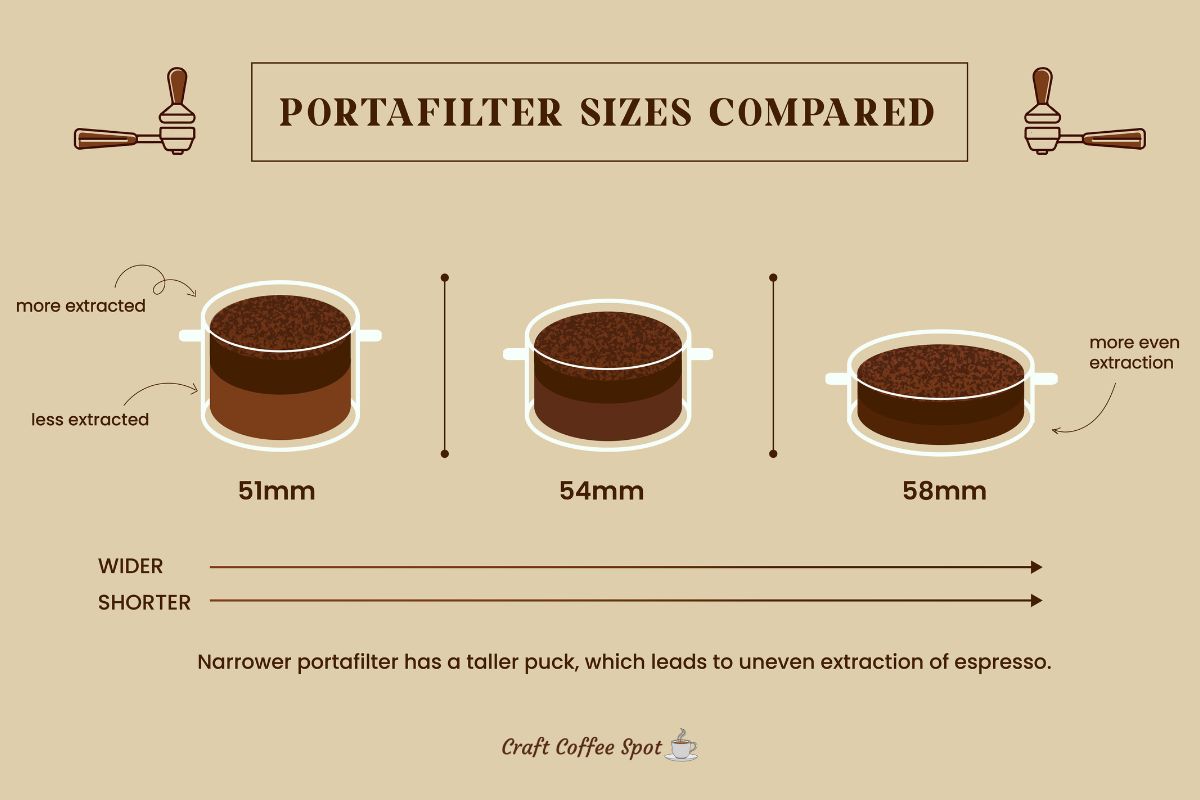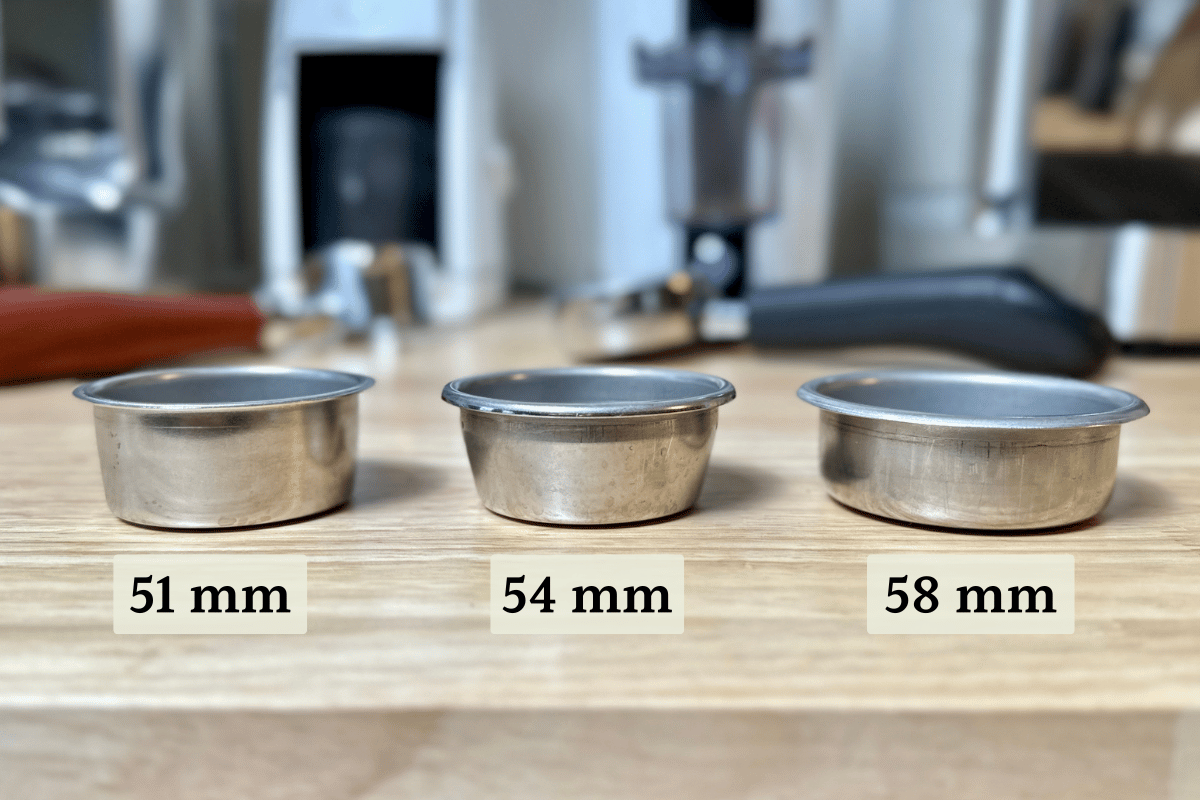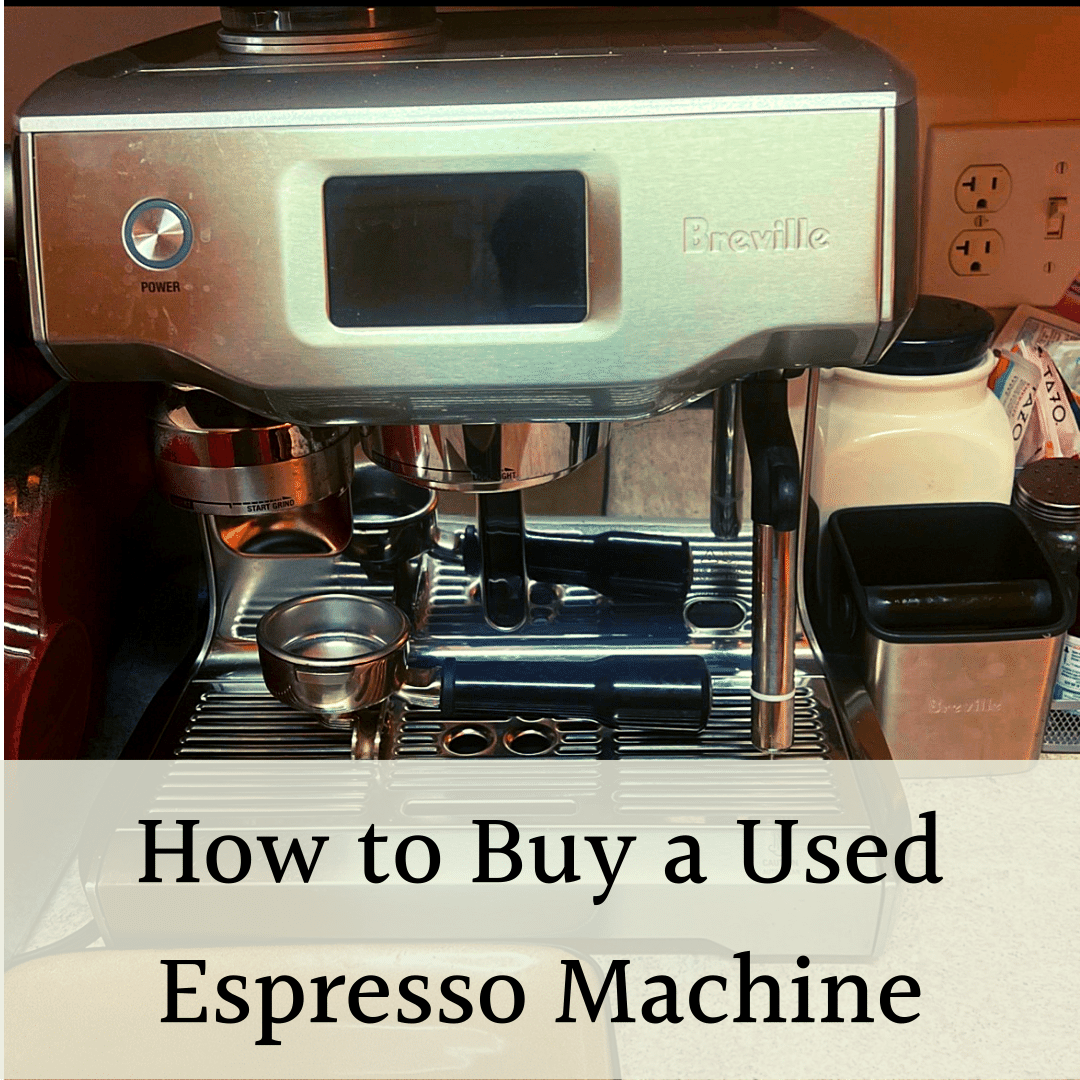Not all portafilters are created equal. Portafilters come in a variety of sizes, including 51 mm (DeLonghi), 54 mm (Breville), and 58 mm (most common for commercial machines). What’s so different about these portafilter diameters?
The size of your portafilter basket (measured by diameter in millimeters) can add body or clarity to your espresso, but the effects are subtle. A larger 58 mm portafilter will improve clarity, while a smaller 51 mm portafilter may add body.
In this article, I’ll get into the weeds of extraction science and walk you through how portafilter size affects extraction.
For the average home barista, it’s good to know what different portafilter sizes do, but I’ll also explain why it’s important to spend time focusing on other brewing variables, like the coffee beans you use or the distribution of coffee grounds.
Here’s our summary of how portafilter size can affect extraction:

Does Portafilter Size Matter?
When asking the question, “Will ‘X’ affect the extraction process and the taste of my espresso?” the answer is almost always, “Yes.” Espresso is a very nuanced brewing method, so every variable has the potential to impact coffee taste. The better question is, “How much does my portafilter size matter?”
Portafilter size affects the extraction process, but it’s not a primary factor in espresso taste. Grind size, water temperature, coffee bed distribution, dose amount, and coffee beans will have a much greater impact on how your espresso tastes. So, if you notice a different flavor in your espresso when using a different-sized portafilter basket, it’s not always clear that the portafilter itself is what’s causing that difference.
Portafilter sizes are not interchangeable between espresso machines, as that is designed into the machine. So, tasting espresso from two different portafilter sizes requires two totally different machines, which adds many other variables that can affect flavor.
All that to say, portafilter size is something to be aware of but not something to base an espresso recipe or machine decision on. Some people have a size preference, but it’s a very subjective factor. I’ve mostly used 54 mm portafilters and 58 mm portafilters on two different machines. I’ve enjoyed the espresso I get from both.
Standard Portafilter Size Comparison
These are the three most common portafilter sizes:
- 51 mm: found on most DeLonghi machines (some older models use 49 mm).
- 54 mm: a common home machine size on brands like Breville or Olympia.
- 58 mm: standard on commercial machines used in coffee shops and is becoming the standard on all machines.

There are a few other portafilter sizes on the market, though they’re far less common. The Flair manual espresso brewer, for example, uses a 46 mm basket (of course, the Flair 58 uses a 58 mm portafilter).
Many espresso machines that don’t use one of the three sizes above probably use a 53 mm portafilter. An espresso machine I have a lot of experience using, the Luca A53 Mini, for example, opts for the 53 mm size.
There are the odd 56 mm, 57 mm, or 52 mm here and there, but you’re unlikely to run into those if you’re using one of the more commonly available home or commercial espresso machines.
How Portafilter Basket Diameter Affects Coffee Taste
So, why do all these different sizes matter? To explain that, we’re going to have to do some math.
An espresso portafilter is sized by diameter, in millimeters. The wider the diameter, the more coffee can fit on the bottom of the basket. For example, a 58 mm basket might have room for 1g of ground coffee to be spread evenly across the floor of the basket. A 54 mm portafilter might only be able to fit 0.9g on the bottom, and the remaining 0.1g would have to go on top of that first layer of coffee.
In other words, the size of a portafilter basket affects how the volume of an espresso puck is distributed: wider or taller.

The volume of a cylinder (which is what an espresso puck is) is calculated using the formula V=πr2h. In this formula, V is volume, r is radius (one-half of diameter), and h is height. If you use the same dose of espresso in each portafilter, the volume will always be the same, no matter the portafilter size. What changes is the height of the puck based on the radius of the portafilter.
So, we end up with a new formula to calculate the height of a coffee puck based on the portafilter size: h=V/πr2
Let’s plug some numbers in to see just how much of an effect portafilter size has on coffee puck height. I’ll assume an 18 g espresso puck has a volume of 18 cm3 (this is a purely hypothetical number). If I use a 51 mm portafilter, the radius is 25.5 mm.
The formula for the height of the coffee puck: 18,000/π25.52 = 8.81
That means the puck is 8.81mm tall. Now, let’s use the same formula for a 58 mm portafilter.
The new formula: 18,000/π292 = 6.81
So, a 7 mm difference in portafilter size reduces the puck height by almost 25%. Since diameter affects volume exponentially, the portafilter size makes a large difference. This gets to how portafilter size affects espresso.
When brewing espresso, the water will first extract the coffee at the top of the puck. The coffee at the bottom will get extracted last. When the water makes it to the bottom of the puck, it’s already partially saturated with coffee particles, so it doesn’t have as much room to extract even more from the ground coffee at the bottom of the puck. In other words, the bottom of the puck is going to be more under-extracted than the top of the puck.
A taller puck means water spends even more time traveling through the coffee before it reaches the bottom of the puck, all the while becoming more and more saturated with coffee. That allows even less of the bottom layer of ground coffee to be extracted than in a shorter puck, creating more uneven extraction.
Here is our infographic again with detail:

A taller or deeper puck also creates more resistance to water pressure because of the longer distance water has to travel before being able to release the pressure. Pressure differences can result in different extraction levels, similar to how brew time affects extraction. Higher resistance, and thus pressure, produces more extraction, resulting in a richer, fuller-bodies coffee.
This can also mean that you need to grind finer to get the same results with a bigger portafilter since the thinner puck offers less resistance to the water.
Note: For a fuller discussion of puck resistance and its effect on espresso, read this study from Coffee Ad Astra.
While these extraction differences sound problematic, it’s not something to worry about. In reality, there is no such thing as perfectly even extraction, and all shots have some level of uneven extraction.
Portafilter size, and thus puck height, affects the extent of that unevenness. Like with many espresso variables, that’s not inherently good or bad. It’s just different. A bigger portafilter can produce a cleaner, brighter espresso shot that tastes better by itself. A smaller portafilter might create an espresso shot with more body that pairs well with milk in a latte or cappuccino.
Even that is subjective, though, and it’s worth noting that these differences are very subtle. In a blind tasting, I couldn’t confidently tell you if two espresso shots were brewed with two different-sized portafilters. Even if they tasted different, it’s hard to know if the portafilter size was the cause. Like I said, there are so many variables that affect espresso (coffee grounds distribution, grind size, etc.), and portafilter size is just one of them. Of course, the most important variable is still coffee beans, and some coffee roasters explain how bean characteristics affect brewing.
It’s good to be aware of the effect of portafilter size on your shot, but I wouldn’t let it keep you up at night. If I noticed a difference in the flavor of my espresso, I’d tweak almost every other variable before I even considered trying a different portafilter size. You should be able to brew a delicious espresso shot regardless of the size portafilter you use.
Note: If you do notice an odd taste in your shot and want to diagnose the problem, it helps to use bottomless portafilters rather than spouted portafilters. This lets you view the extraction process and allows you to see issues like channeling or uneven water flow.
Choosing the Right Portafilter Size
The most important factor in determining what portafilter size to use is what espresso machine you want. Portafilter basket sizes aren’t interchangeable, so if you have an espresso machine with a 54 mm group head you have to use a 54 mm portafilter.
The espresso machine itself should be a bigger consideration than the portafilter size since that will have a larger impact on the overall quality of your shots. Generally, a larger portafilter will produce cleaner, more silky shots, and a smaller portafilter will produce richer, full-bodied shots.
There are other ways to get those same profiles despite your portafilter size through your choice of beans and your puck prep. I recommend using portafilter size as a last-ditch tie-breaker if you’re torn between espresso machines that seem equal in every other way.
The most practical benefit to using a particular size is that most espresso accessories are made to fit 58 mm portafilters. That size is the most common, so it’s easier to find tools that fit it than others. However, this has changed a lot recently with more tools for Breville 54 mm and Delonghi 51 mm portafilter diameters.
Portafilter size might affect an espresso shot, but I recommend letting your machine preference make the portafilter size decision for you.
Finding the Right Espresso Machine
For help choosing an espresso machine (and a portafilter size), read through our buying guide for the best beginner espresso machines.




